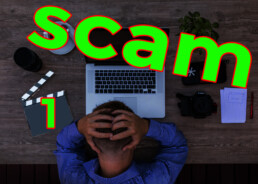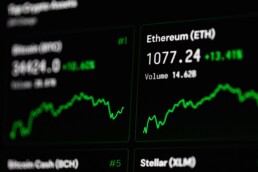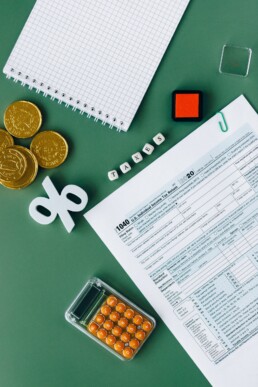Doing the right thing. Before the inevitable end of your life.
I recently lost my father.
After a long illness, after a bad deterioration period of time, he passed away in a hospital bed in his sleep. Painlessly, in complete peace. And we were with him.
When a father dies in a family it is always a tragedy since generally the male figure is the one who guides the choices and direction of any economic nature and brings home the largest share of the family income.
After coming to terms with the pain of loss and dealing with everything that comes after a bereavement, I stopped one evening to think about my situation at the time.
My father's long illness, had allowed my mother and me to handle family matters as best we could. We had had plenty of time to do things right, but more importantly, to have an overview of our situation. That overview that is sometimes lacking in a family.
And I stopped to think about those families who go through bereavement and have not been as fortunate as I have been. How to do that in this case?
You who are reading, I assume that you are the one in the family who takes care of the boring financial matters. I assume that you are the one who makes the decisions and has the idea of the big picture. Let's start with what experience has taught me.
The first thing to consider is information asymmetry.
Since you are the one in the family dealing with these things, most likely your partner doesn't know anything about it. And that is not necessarily completely wrong. We have to consider the amount of things there are to do, the different interests of the two partners, and the personal predisposition of each.
But you have to consider, though, that the moment you are gone, your wife or husband will have to take over your financial management and they will have to put the pieces together and figure out what to do and who to talk to.
If I can give you a tip, try to leave everything written and create something foolproof.
Account numbers, passwords and logins, who to contact and why, trusted people to turn to who can help those who find themselves managing this situation.
These are trivial things that we don't think about, however. The basic principle is to handle this situation by trying to leave emotions aside and make the job easier for those who will be there after you.
Educating your wife or children about economics and investing, that is a good job to do. It will be difficult, especially if you lack motivation and desire.
Also because, let's face it. you are dead, you certainly can't suggest account passwords to your wife in her sleep.
The Scam List - A guide to avoid scam Part 1
The world of cryptocurrencies is full of people who want to scam you. In reality, the real world is like this, but the crypto world as it made, makes scams much easier, faster and above all painful. Like any other user, you have to protect yourself and the best thing to protect yourself is to know everything about scams, so you can recognize and avoid them.
Below you will find a list of typical scams that see innocent and sometimes inattentive users lose money.
Cryptojacking
Let's start with cryptojacking or crypto mining.
Cryptojacking is a type of cyber attack that uses the computer of users infected with malware to mine cryptocurrencies without their consent and without their noticing.
Due to high processor usage, computers infected with this type of malware tend to run slowly and overheat.
It is a threat that can compromise all types of devices, from PCs to smartphones and even network servers.
Instead of creating mining farms with their own machines, in this case the hacker creates a "clandestine" mining farm by exploiting and stealing computing power from infected users, at no cost to the hacker. In fact, mining brings a strong stress to the machines used for m in addition to high energy costs
One of the most popular ways of infection is through phishing emails with malicious links or attachments that install malware, or through infected websites with malicious scripts: when a user connects to such sites, they start undermining without realizing it. Many adult sites have these malicious scripts that allow cryptojacking.
At the moment the threat is recent and not all popular antiviruses are ready to fight it are protected.
Among the most well-known malware, PsMiner, a malware for Monero mining designed for Window and CookieMiner devices, which was in turn designed for mining Koto, a Japanese cryptocurrency
Some of these malware then manage to steal user data, so they can have access to your access to wallets and exchanges. Try to prevent getting infected with these malware with basic behaviors such as not opening suspicious e-mail communications that carry fraudulent links, or visiting sites whose safety has not been verified. In short, no more porn.
The fake broker.
It happens to receive unwelcome phone calls from people we do not know, from strange call centers who would like us to invest in bitcoin or ethereum. Generally the people on the other side of the phone know less than we do but they know how to hit our ego by promising staggering returns with virtually zero risk and no bureaucratic problems since they would take care of every aspect of the investment. It's just a question of making a money transfer, and seeing the value of your investments grow dramatically.
Let's assume that our friend Luca falls into the trap and decides to trust this broker. He will begin a process in which all documents will be requested to start creating the account on a trading platform, based abroad in countries such as Romania or Cyprus. The anti-money laundering procedures will be serious and tight, convincing Luca that the broker is serious.
Luca makes the first deposit of $ 20,000 by wire transfer or credit card and within a few weeks the coins are purchased. The platform issues all the purchase tax documents to luca, so as to be in perfect order with taxation burocracy. But suddenly, the broker asks Luca for another $ 10,000 if he wants his previously paid $ 20,000 back.
Luca refuses and the trading company disappears.
Luca tries to recover his money through the trading platform but here he understands that he is not the owner of the crypto. In fact, the fraudster Broker has deposited the coins, bought with Luca's money, on his own proprietary wallets. Basically Luca gave money to the scammer.
The money is lost, the broker is unable to do anything as the scam has been well researched. Luca feels the pain of being scammed. He hasnt done the right research.
False identity
The crypto community mostly uses telegram and discord. This allows you to contact anyone in this world, managing to have contacts with programmers, influencers, CEOs and traders. And this allows anyone to contact you too.
It often happens to be contacted by people who are famous in the environment or who boast of working for very famous start-ups or crypto companies. I warn you, if you have not known them personally, all of these people are scammers, who have stolen the identity of people in the environment and who sooner or later will ask you for money or to reveal the private keys of your wallet.
It takes little to create a fake profile on telegram, a photo copied from the correct profile and a similar username. And that's it.
Never send sensitive information to anyone, information such as passwords or private keys, or make coin payments. If any of these villains contact you, block them mercilessly.
Do you want to discover some new scam? Go to the second part of our guide!
Toxic Asset
In this article we will talk about the toxic assets in the belly of banks. What they are and why they are in your bank's balance sheets.
Banks have various assets within their balance sheets. among these we can find bonds, shares, loans and then various derivatives such as MBS mortagage backed securities, CDO and CDS (Credit default swaps).
The part that could be toxic almost all of the time are the last 3 elements, which are derivatives. These derivatives are created through securitisations.
Securitization is a financial technique specially designed to transform non-transferable financial instruments into other transferable financial instruments.
These transactions can generate cash flows, such as bank loans, and are "transformed" into divided and salable assets into bonds called Asset Backed Securities (ABS).
This financial activity is carried out to drain additional monetary resources from the market. Its popularity as a tool for raising loans has grown considerably in recent years, which has allowed banks to feed into the subprime mortgage granting mechanism.
Based on the securitized underlying, we can speak of securities like:
MBS (mortgage backed securities, the underlying of which are mortgages),
CDO (collateralized debt obligation, the underlying of which are public or private bonds),
ABCP (asset backed commercial paper, which are short-term credits).
To give you an example of real securitization, you have to think of a bank that has a number of real estate loans among its activities; if the bank decides to securitize these assets then it will issue securities, which have home loans as collateral, which will be sold to private or institutional investors.
Our bank sells this group of mortgages to a Special Purpose Vehicle (SPV for short), created specifically for the purpose, which issues bonds (in the specific case of mortgages, Mortgage Backed Securities) which sells to investors like Pension Funds.
The risk is transferred by the bank to the final subscribers of the bonds,the payment of interest of the bonds are linked to the effective collection of the interests of the loans themselves.
Understand that if these mortgages go unpaid, investors will see the value of their bonds go to zero. In the years before the subprime mortgage crisis there was a very sustained growth in securitisations all over the world, reaching a peak of approximately $ 11 trillion in the United States and € 2 trillion in Europe.
Understanding what a securitisations is, let's get back to our toxic assets.
Sometimes banks don't really know what's in their belly as the rating agencies haven't done a real due diligence, so the risk is masked or hidden and in the end the banks have bought assets whose problem only comes to the surface at the worst moment , like when debts are not paid.
Let's show another example, let's assume that all these assets are placed in a box and divide it into 3 parts.
We would find truly toxic assets, like financial products based on loans that will never be paid such as car mortgages, credit cards, home mortgages and personal loans.
Unfortunately, we all know someone who lives far beyond their possibilities. That someone is our toxic asset creator.
So these assets, which the bank paid at 100, are actually worth almost zero.
A second type of asset that we could find are long-term assets, or assets that today may seem toxic but which in the long term can be of excellent quality.
Think of a credit given to a company, like your neighbor who works seven days a week in his engineering company, which despite being small is an excellent shop, which has just modernized all its machinery. This company will be burdened with a large debt but with new machinery and its good management, within a few years it will pay off the loan and be profitable.
If the economy starts to grow again this kind of debt will all be repaid, so they are good in the long run but are also potentially toxic if the economy stalls or worse collapses
The third part, on the other hand, is made up of good payers, the couple who lives in the apartment next to yours and who have just changed the car for a bigger one because they want to expand their family. They are both employees, so they have a stable job and this potentially puts them in the category of debts that are paid consistently and always on time. These are great assets. They are owners of credit cards that pay their debts, mortgages that are regularly paid off, etc.
Now let's look at everything in terms of the economy. At a time when the economy is in dire straits and slows down
The first group, toxic assets, actually has zero value.
The second group, the potential assets that the banks have paid at full price, begin to lose value.
The loss of value is not given by the payment problems by the debtors but because these assets are poured into the market because the banks have to cover their expenses and then sell them to make cash but the large amount of assets on the market causes the price to drop to a tenth of the initial value.
The second group would be an asset to be held but the banks need cash. Fast.
And the problem worsens as banks will have to account for these assets with their market price, no matter if the bank believes the value is 100. If the market prices at 50, this will be the value to be accounted for
The more pressure there is on the bank and other banks, the more they will have to sell these assets. Assets that are not toxic to payers, but toxic to the bank
As the economy continues to deteriorate, it is likely that the bank will also have to sell the assets of the third group, the best of the lot. This unfortunately in turn leads to a fall in the price of top quality assets and this means that even these become potentially toxic for the bank.
As you can see, everything is originated from the initial toxic assets.
CBDC - the DCEP Digital Yuan
Not so long time ago, we crypto people were insulted, called thieves, evaders and money launderers. And then, some time passes by our government start talking about Central Banks Digital Currency and all the banks start to sell bitcoin.
Oh well it's always like this. But let's talk about the first authorized state cryptocurrency, namely the Digital Yuan or DCEP, which will surely be a nice tool in the hands of Chinese economic policy.
Dcep is the acronym for Digital currency electronic payment and will be a national digital currency, or a digital national currency, or a digital form of FIAT currency.
Precisely in its digital form, one of the DCEP missions is the replacement of paper fiat money, practically what we hear about the abolition of cash to bring you to a society that can be defined as cashless. It should be noted that digital payments with apps such as WeChat are currently the norm in China and the change would not be as drastic as in European societies.
Let's go into the details of the Digital Yuan. This will be created by the PBoC People bank of China, it will be a centralized currency and will not be minable or stake. At the time of the creation of this video, the system is in the testing phase but in the Chinese government's plans there is the will to reach full operation and replace paper money by 2022. And I'm sure they will succeed.
The blockchain system on which the coin will run is called Chinas Blockchain Service Network BSN and is managed by a Chinese government agency that also manages some of the major state telecommunications companies such as China Telecom and China unicom. The BSN is designed to be easy to use and to be able to develop and operate nodes and applications on the blockchain.
At the time of writing, the digital yuan is only accepted in some chains in China, but the government has issued a decree requiring all merchants that accept digital payments such as AliPay and WeChat to also accept Dcep. These tech giants are also rocketing to make the currency compatible with their payment systems. In a short time, the DCEP will become the most used digital currency in the world.
In fact, even its practical use is oriented towards its diffusion. In fact, it uses the NFC system, which does not require your mobile phone to be connected to the internet during the transfer, which means that it can also be used in areas without a connection. It doesn't even require your wallet to be linked to a bank account. Think of all those people in the world who do not have access to banks, not only in China but also in all African countries. These people will be able to use the digital yuan without any problems.
The Dcep built on the blockchain and with cryptographic technology is designed to spread as a payment method in the world, dramatically increasing the circulation of the Yuan and competing with the US dollar as a world currency.
China wants to become independent from the dollar, protecting itself from possible sanctions and trade wars. With the digital Yuan we not only have a payment system but a system of geopolitical influence, which will transform the world as we know it.
I am sure that in a short time we will see similar currencies developed by the United States and the European Union as well.
It should be specified that the DCEP is very different from Bitcoin, since it is totally centralized and in the hands of a government. This will give full traceability of payments, preventing money laundering and illegal payments if possible. It will be the umpteenth instrument of citizen control in the hands of the state.
Why do altcoins exist?
Why altcoins exist? and what are they for?
Alt coin is the abbreviation for Alternative Coin, or coins alternatives to Bitcoin.
Bitcoin as we know was the first truly successful cryptocurrency, which show the way for all those who followed it.
But Bitcoin is not perfect and altcoins are used to create a hypothetical better version of bitcoin or a coin that has different purposes and functions from those of Bitcoin, in fact some of them are faster than bitcoin, others focus on anonymity, others do different things like ethereum and others.
Altcoins can then be mined in a different way, for example bitcoin has an algorithm called SHA 256, an altcoin like Litecoin, which derives from Bitcoin, has a different algorithm called Scrypt.
There are now thousands of altcoins on the market, but only a very few have achieved a decent fan base. We must in fact divide the coins that have a utility, the coins that are based on projects that do not really have to do with the blockchain and coins that are exclusively scams or useful for the Pump and dump.
A good way to analyze the coin we have spotted is to understand if it has a following by first checking the market cap and then the community of users who use or follow it.
The market cap is the term used to indicate market capitalization.
This is calculated by multiplying the number of coins in circulation by the price of the exchange. A high value generally indicates a certain interest from the world and therefore value within the coin.
Remember that you can invest in an altcoin both when it is already on the market and before it is issued, in what are the famous ICOs.
if you want to invest in an altcoin, in the post ICO period, in general you will have more information and less chance to buy a scam but most likely if the coin has an actual use or value, you will pay much more than the price of the ICO.
So inform yourself and study well and always beware of ponzi schemes and fraud.
Learn more about Scam here.
Exchanges and Order
Exchanges are the places where sellers and buyers meet together. This online sites are dedicated to the trading of various cryptocurrencies.
There are various types of exchanges, from the largest and most established with users from all over the world to the smallest ones that have a predominantly regional audience, as it happens in Japan and Korea.
The main features that interest us in an exchange are which coins are traded, the volumes and costs of the exchange and the safety of the sites.
Security as you well know is the fundamental factor of this world, and it weighs on your shoulders.
Exchanges work just like the stock exchange and manage your money. There is an order and sales book, you will have your own personal wallet but owned by the exchange. With some of these wallets you can even make loans to other users and get paid.
Now, there is no 100 percent secure exchange and these entities are in the hands of companies that obviously have profit as their reason for existence. Exchanges can be attacked by hackers or they can scam users, blocking funds and running away with money. For this reason you will have to leave as few coin or currency as possible on the exchange.
The largest exchanges are structured to resist to attacks and attempted robberies, but the provision is never too much. Each exchange takes care to put you in a position to protect your account, so don't be lazy and take the necessary actions to protect yourself
Moving on to coins, here we have another difference. In almost all exchanges bitcoin is traded but some small coins, with very low volumes and illiquid, are traded only on one or two exchanges in the world. This forces us, if we want to betray them, to rely on these actors who are unknown to most. In this case we will have to read the rules of these exchanges because they may not allow the exit of funds below or above a certain value, or forcing us to go through the kyc procedures and this may take a long time to be resolved.
The volumes of an exchange are an important signal, meaning that that data coin on that given market is very or little sold and in demand. Many volumes equate to many buyers and sellers, therefore a market rich in money that is defined as liquid. Small exchanges with low volumes are therefore illiquid.
Each exchange has usage costs, check them before deciding on which exchange to operate more often.
Also remember that although bitcoins are all the same, on different exchanges they are sold at different prices, giving rise to arbitrage phenomena.
When you go to trade on exchanges, you will have different types of orders to buy or sell. Let's see some of them.
Let's start with the simpler than the market order or market order. In this specific order, the purchase takes place at the sale price of the lowest asset and the order is not stopped until the requested quantity is reached.
Let's take an example. I purchase 20 ethereum with a market order. At that moment on the book, the first lots on sale at the lowest price will be 10 ethereum at $ 200 and another 20 at $ 210.
With this order I will buy 10 ethereums for $ 200 and another 10 ethereums for $ 210. With this order, the price does not matter, but the quantity indicated.
In the case of a sales order of this type, the behavior is the same.
Another kind of order is the limited order. In this case, when we go to create the purchase order, we enter the quantity and the decided price. In this case we can put a price slightly below that of the moment or much lower, it all depends on how we see the situation on the market. This type of order could be either unfulfilled or partially filled.
Again using the example above, if we placed an order for 20 ethereum at $ 200, with a current price of $ 210, we would have to wait for a descent to ensure that the order is executed. It could happen that only 5 ethereums on the market sell for $ 200, so our order would be partial.
Also in this case when the behavior of the order in the event of a sale is the same. Price and quantity will be fixed and may not be reached.
A more complicated type of order is the stop loss order. This kind of order incorporates a sales strategy that wants to cut losses, a stop loss in fact. When the trend is uncertain you can use this order to protect yourself.
In case we still have an order like this for 10 ethereum at $ 200, with a stop loss at $ 190. If our long view is right, from our purchase at $ 200 ethereum it will go up in price and at the right time we will take profit. However, if we made a mistake and ethereum starts a negative trend, our order will automatically sell the position at 190 dollars, saving our account.
Viewed from the point of sale, this type of order can be changed with a higher price which turns into a take profit. If ethereum begins a slight positive trend we will be able to move the stop loss in equal to $ 200 or if the rise is more pronounced the figure could be even $ 210 and beyond. In this case we would continue to have a position within an uptrend that would be sold for a gain in the event of a reversal of the trend.
Junk Bond
Junk Bond. Silly term heard on the news before sitting down at the table for dinner. What is it about?
Bond means debt. Government Debt. The term junk in this case stands for garbage, something that should be thrown away.
But when we talk about junk bonds, at the moment we are talking about something very "popular".
With junk bonds we describe high-yield bonds, a yield given by their high risk.
It should be understood that higher the risk of lending money to a company or a country that could be insolvent, the higher the return for the lender must be.
When you go to lend money to risky companies by buying their securities, you are entering a risky business.
These companies may be in some risky businesses or economic sectors or they just have too many debts due to bad management or moments of crisis. By investing in this risk you will end up having big interest at the end of each year or month, depending on the instrument chosen.
Unfortunately, however, if these companies are badly managed you may have some small economic satisfaction at the beginning and then end up losing your capital.
Or on the other hand, these companies are well managed, you will have an excellent return and then get all your investment back.
High Yields companies create bonds that are risky and therefore are considered with a very low rating, therefore with a very high yield on the contrary, the so-called investment grade bonds that have a very good rating score have a lower yield.
But what does Yield mean?
Let's see how the yield of a debt security works like a normal corporate bond, we are not talking about Junk Bond and the figures entered here are by way of example.
let's assume that Luca buys a 100 euro bond from GoGA GMBH, with an annual yield of 5%
So Luca lends 100 euros, and in exchange he has a piece of paper that says that he has lent 100 euros to the GoGa and that at the end of the year at the end of the bond he will receive 100 euros plus 5 euros of interest
the 5 euro of interest is the gain of the financial product and therefore the coupon yield on this bond is defined.
but what happens if luca decides to sell the bond before its maturity
if he sells the bond at a price below 100 (which is the base price of each bond), let's assume 95.
sells the bond to Marco. Marco expires the bond and then receives 105 from the company, so Marco's yield becomes 10 and no longer 5 as in the case of luca
as the bond price falls, the yield increases
on the contrary, if Marco buys the bond at 101, his yield will be only 4, with a decrease in the yield.
this is the basis of how yield works
Security and personal hardware
With the use of digital assets in the blockchain sector, it is good to start with an analysis of your computer and smartphone, and their safety. It is good practice to always have the operating system updated to the latest security patches, and consequently all the programs installed on the PC. The use of the latest generation paid antivirus is essential. Let's destroy a myth, there is no best antivirus but good antivirus (do your research and buy a license). We reiterate the importance of having a good antivirus as many malware are designed to steal data relating to cryptocurrencies (your assets).
It is also not recommended to connect to public wifi connections, it is better to use your own data connections, and to implement the use of vpn (virtual private network) to secure your connections. There are many very affordable subscription plans.
It is essential to have a back up of your private keys and passwords off line, not on the computer in use, as if you were to fall victim to the notorious cryptolocker, we will lose all data (all the contents of the pc will be encrypted), and to obtain the key we will be forced to pay cybercriminals in bitcoin. So, watch out for email scams. Never open an attachment if you are unsure of the sender.
When using a smartphones we highly recommend an antivirus / antimalware updated to the latest definitions. The VPN contract certainly provides for use on multiple devices, so we are going to take advantage of the usual subscription also on smartphones.
If you also use your smartphone for work, for leisure (social, chat of various kinds, entertainment for adults), you will create a promiscuity with the operations in the field of cryptocurrencies, so it could be optimal to use a dedicated smartphone . For those who are obsessed with security, we can also indicate a specific smartphone, the htc Exodus created to ensure maximum security in the context of the blockchain.
Small but fundamental mention of the use of 2FA (two factor authenticator) for access to the various exchanges, in order to make operability with your own cryptocurrencies even more secure.
Learn more about safety here.










